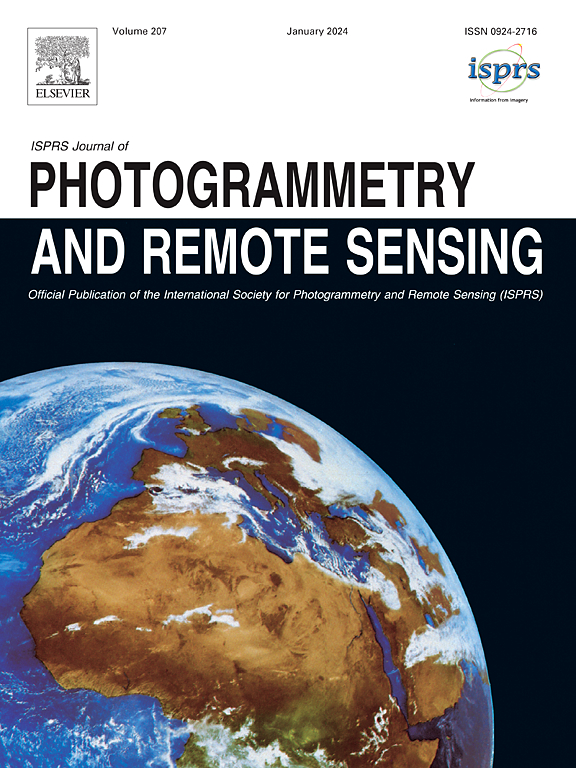A robust method for mapping soybean by phenological aligning of Sentinel-2 time series
IF 10.6
1区 地球科学
Q1 GEOGRAPHY, PHYSICAL
ISPRS Journal of Photogrammetry and Remote Sensing
Pub Date : 2024-10-17
DOI:10.1016/j.isprsjprs.2024.10.015
引用次数: 0
Abstract
Soybean is an important crop for food and animal feed. Production and area both continue to increase and expand into new areas and countries. Spatially explicit information on soybean cultivation is essential to crop monitoring, production estimation, and national accounting systems. However, its cultivation in diverse climate conditions, landscapes, and agricultural systems poses challenges to accurately map soybean across different regions and years. We propose an innovative soybean mapping method combining phenological alignment with machine learning (named here RF-DTW), which can be applied to diverse geographies and years by aligning phenological shifts and using distinctive features from Sentinel-2 time-series. The method first uses the dynamic time warping (DTW) algorithm to align the growing season between pixels across different sites. Then, based on the harmonized time-series, a set of distinctive features was identified and used to build random forest (RF) models to classify soybean across ten globally distributed sites and multiple years. Results show that the green chlorophyll vegetation index (GCVI), greenness and water content composite index (GWCCI), normalized difference senescent vegetation index (NDSVI), red edge position (REP), and short-wave infrared bands are important inputs for distinguishing soybean from other crops. Spectral-phenological features, particularly the curve slope metrics of GCVI and GWCCI during the peak to late growing season, rank as the most important features for mapping soybean. RF-DTW demonstrates good generalizability across ten study sites, achieving an overall accuracy (OA) of 0.92 and an F1-score of 0.84. F1-scores for eight out of ten sites ranged between 0.82 and 0.98, outperforming a benchmark method, although they were lower (F1-score < 0.60) for the two sites in Sub-Saharan Africa. Additionally, RF-DTW performs robustly when transferred to untrained regions and years, with most cases showing an F1-score higher than 0.70. Our proposed method, as a combination of phenological alignment and machine learning, can be used to map soybean accurately and efficiently across different regions and years, to provide crucial information for understanding the rapid dynamics of soybean cultivation and its global-scale impacts.
通过对哨兵-2 时间序列进行物候配准绘制大豆地图的稳健方法
大豆是重要的粮食和动物饲料作物。其产量和面积都在持续增长,并向新的地区和国家扩展。大豆种植的空间信息对于作物监测、产量估算和国民核算体系至关重要。然而,大豆在不同的气候条件、地貌和农业系统中种植,给准确绘制不同地区和年份的大豆地图带来了挑战。我们提出了一种将物候配准与机器学习相结合的创新性大豆绘图方法(在此命名为 RF-DTW),该方法通过配准物候变化并利用 Sentinel-2 时间序列的显著特征,可应用于不同地域和年份。该方法首先使用动态时间扭曲(DTW)算法来调整不同地点像素之间的生长季节。然后,根据协调后的时间序列,确定一组显著特征,并利用这些特征建立随机森林(RF)模型,对全球分布的十个站点和多个年份的大豆进行分类。结果表明,绿色叶绿素植被指数 (GCVI)、绿度和含水量综合指数 (GWCCI)、归一化差异衰老植被指数 (NDSVI)、红色边缘位置 (REP) 和短波红外波段是区分大豆和其他作物的重要输入。光谱-表观特征,尤其是生长旺季至生长后期的 GCVI 和 GWCCI 曲线斜率指标,是绘制大豆地图最重要的特征。RF-DTW 在十个研究地点表现出良好的普适性,总体准确度 (OA) 为 0.92,F1 分数为 0.84。十个研究地点中有八个地点的 F1 分数介于 0.82 和 0.98 之间,优于基准方法,但撒哈拉以南非洲的两个地点的 F1 分数较低(F1 分数为 0.60)。此外,当将 RF-DTW 移植到未经训练的地区和年份时,其表现十分稳健,大多数情况下 F1 分数都高于 0.70。我们提出的方法是物候配准与机器学习的结合,可用于准确、高效地绘制不同地区和年份的大豆图谱,为了解大豆种植的快速动态及其对全球的影响提供重要信息。
本文章由计算机程序翻译,如有差异,请以英文原文为准。
求助全文
约1分钟内获得全文
求助全文
来源期刊

ISPRS Journal of Photogrammetry and Remote Sensing
工程技术-成像科学与照相技术
CiteScore
21.00
自引率
6.30%
发文量
273
审稿时长
40 days
期刊介绍:
The ISPRS Journal of Photogrammetry and Remote Sensing (P&RS) serves as the official journal of the International Society for Photogrammetry and Remote Sensing (ISPRS). It acts as a platform for scientists and professionals worldwide who are involved in various disciplines that utilize photogrammetry, remote sensing, spatial information systems, computer vision, and related fields. The journal aims to facilitate communication and dissemination of advancements in these disciplines, while also acting as a comprehensive source of reference and archive.
P&RS endeavors to publish high-quality, peer-reviewed research papers that are preferably original and have not been published before. These papers can cover scientific/research, technological development, or application/practical aspects. Additionally, the journal welcomes papers that are based on presentations from ISPRS meetings, as long as they are considered significant contributions to the aforementioned fields.
In particular, P&RS encourages the submission of papers that are of broad scientific interest, showcase innovative applications (especially in emerging fields), have an interdisciplinary focus, discuss topics that have received limited attention in P&RS or related journals, or explore new directions in scientific or professional realms. It is preferred that theoretical papers include practical applications, while papers focusing on systems and applications should include a theoretical background.
 求助内容:
求助内容: 应助结果提醒方式:
应助结果提醒方式:


